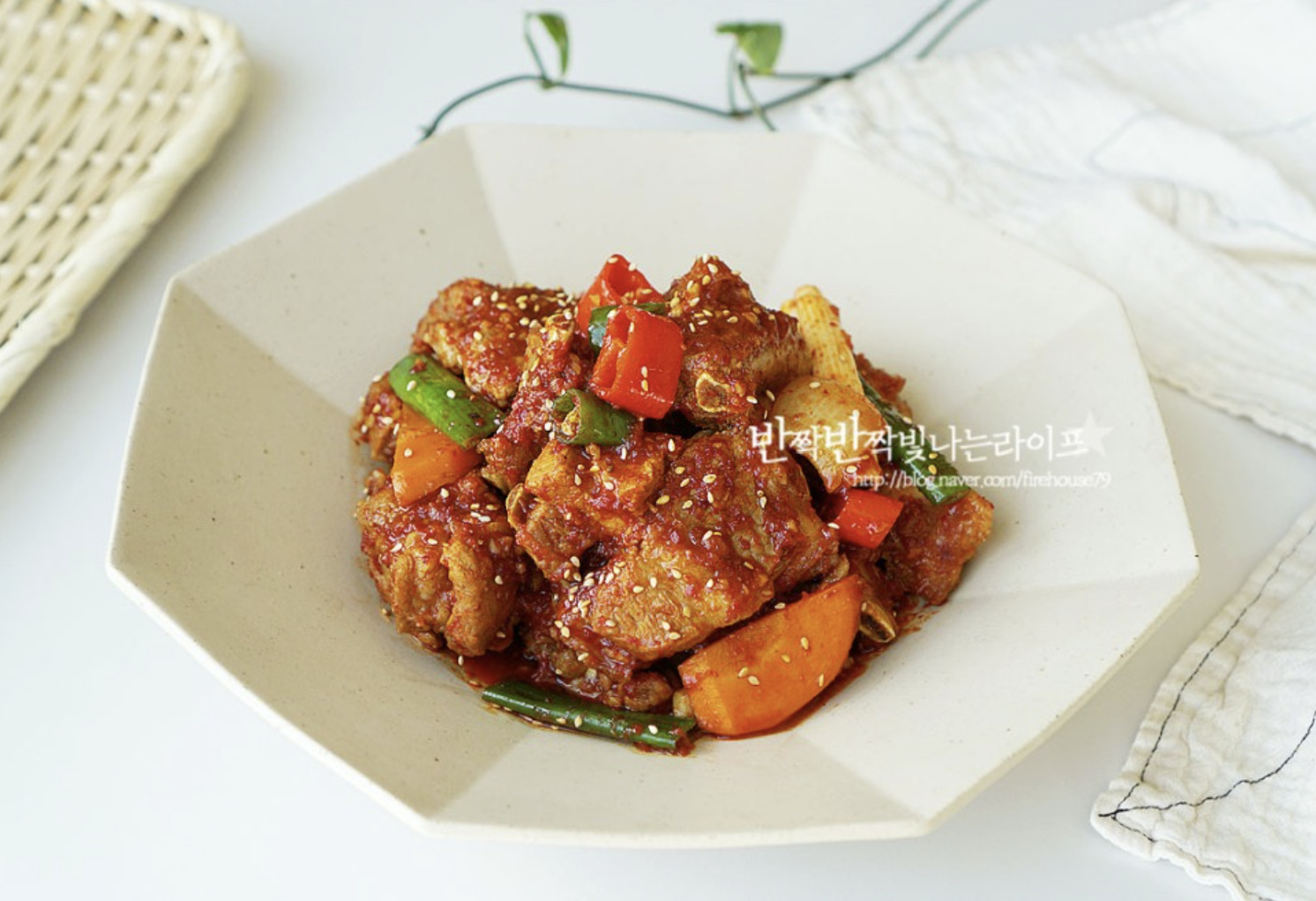Spicy Braised Pork Ribs (Maeun Dwaeji Galbi Jjim): The Ultimate Flavorful Dish
How to Make Deliciously Spicy Braised Pork Ribs

While I usually make this dish with a soy sauce-based marinade to suit children’s palates, today I’ve prepared a spicier version that’s perfect as a flavorful side dish for rice or a delightful accompaniment to alcoholic beverages. Get ready for a truly satisfying culinary experience!
Main Ingredients- 1kg Pork Ribs for Braising (bone-in)
- 2/3 stalk Green Onion
- 1/2 Onion
- 1/6 Carrot
- 1 Cheongyang Pepper (Korean red chili pepper)
- 1 Red Chili Pepper
- 250ml Water
- 1 Bay Leaf
- 10 Peppercorns
- 2 Tbsp Mirin (or Rice Wine)
Spicy Marinade- 4 Tbsp Gochugaru (Korean chili flakes)
- 2 Tbsp Gochujang (Korean chili paste)
- 5 Tbsp Soy Sauce (for braising)
- 2 Tbsp Fish Sauce (or regular soy sauce)
- 2 Tbsp Brown Sugar
- 2 Tbsp Oligodang (or corn syrup)
- 1/2 Apple, juiced (about half a small apple)
- 1 tsp Grated Ginger
- 1 Tbsp Sesame Oil
- Pinch of Black Pepper
- 4 Tbsp Gochugaru (Korean chili flakes)
- 2 Tbsp Gochujang (Korean chili paste)
- 5 Tbsp Soy Sauce (for braising)
- 2 Tbsp Fish Sauce (or regular soy sauce)
- 2 Tbsp Brown Sugar
- 2 Tbsp Oligodang (or corn syrup)
- 1/2 Apple, juiced (about half a small apple)
- 1 tsp Grated Ginger
- 1 Tbsp Sesame Oil
- Pinch of Black Pepper
Cooking Instructions
Step 1
The first crucial step for delicious pork ribs is to remove the blood. Soak the pork ribs in cold water for at least 1 hour, or up to 2-3 hours, changing the water occasionally. This step is essential to eliminate any gamey odor and ensure a clean flavor. You can also gently scrape off any bone fragments during this process.

Step 2
Prepare a pot for parboiling the ribs. Fill it with enough water to cover the ribs. Add the green parts of the green onion, 1 bay leaf, and 10 peppercorns to the water. These aromatics will help neutralize any unwanted odors.

Step 3
Once the water is at a rolling boil, carefully add the blood-removed pork ribs. Also, add 2 tablespoons of mirin (or rice wine) to help tenderize the meat and further remove any lingering smell. Parboil over high heat for about 5-7 minutes.

Step 4
After parboiling, rinse the ribs thoroughly under cold running water. This will remove any impurities or bone fragments that may have surfaced. Drain the ribs well in a colander. Ensuring the ribs are well-drained is important for the marinade to adhere properly and for even cooking.

Step 5
Now, let’s prepare the spicy marinade. In a bowl, combine the gochugaru, gochujang, soy sauce, fish sauce, brown sugar, oligodang, apple juice, grated ginger, sesame oil, and black pepper. Mix everything thoroughly until well combined. The apple juice not only adds sweetness and umami but also helps to tenderize the meat. Stir until the marinade is a smooth, cohesive mixture.

Step 6
Place the parboiled and drained pork ribs into a pot. Pour in the prepared spicy marinade and 250ml of water. Gently toss the ribs to ensure they are evenly coated with the marinade.

Step 7
Bring the mixture to a boil over medium-high heat. Once boiling, cover the pot and let it simmer for about 10 minutes. This initial simmering allows the flavors to penetrate the meat.

Step 8
While the ribs are simmering, prepare the vegetables. Chop the green onion and onion into large pieces. Cut the carrot into similarly sized chunks. Slice the Cheongyang pepper and red chili pepper diagonally into large pieces for both color and a hint of spice.

Step 9
After simmering for 10 minutes over medium-high heat, reduce the heat to medium and continue to cook for at least 15 more minutes, or until the pork is tender. Once the pork is tender, add the carrots and onions to the pot and continue to cook until they are tender-crisp. If the sauce becomes too thick during this stage, you can add a little more water.

Step 10
When the carrots are cooked to your liking and the sauce has thickened to a glaze, add the chopped green onions and chili peppers. Stir briefly, just enough to wilt the vegetables slightly. Overcooking them will make them mushy. At this point, taste the sauce and adjust seasoning if needed by adding a little more soy sauce or salt.

Step 11
The dish is now complete, featuring rich, glossy red sauce coating the tender pork ribs, making it incredibly appetizing! This dish is a perfect match for a warm bowl of rice or a delightful pairing with a cold beer or soju.




